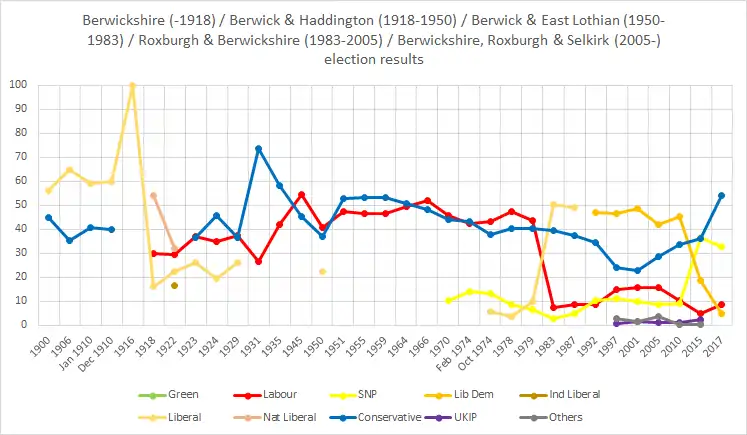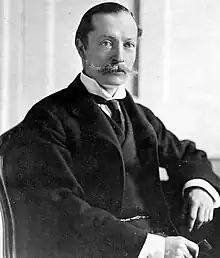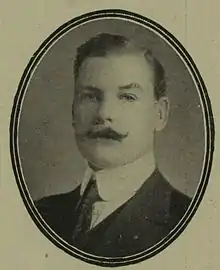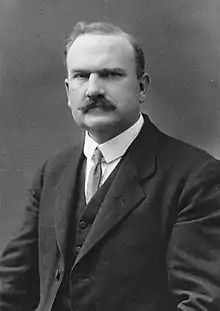| Berwick and Haddington | |
|---|---|
| Former County constituency for the House of Commons | |
| Subdivisions of Scotland | Berwickshire, East Lothian |
| 1918–1950 | |
| Seats | One |
| Created from | Berwickshire and Haddingtonshire |
| Replaced by | Berwick and East Lothian |
Berwick and Haddington was a constituency of the House of Commons of the Parliament of the United Kingdom from 1918, when it replaced the separate Berwickshire and Haddingtonshire constituencies, until it was renamed Berwick and East Lothian for the 1950 general election. It elected one Member of Parliament (MP), using the first-past-the-post voting system.
The constituency covered the counties of Berwickshire and East Lothian.
Members of Parliament
| Election | Member | Party | |
|---|---|---|---|
| 1918 | John Hope | Coalition Liberal | |
| 1922 | Walter Waring | National Liberal | |
| 1923 | Robert Spence | Labour | |
| 1924 | Chichester Crookshank | Unionist | |
| 1929 | George Sinkinson | Labour | |
| 1931 | John McEwen | Unionist | |
| 1945 | John Robertson | Labour | |
| 1950 | constituency abolished | ||
Election results

Berwickshire constituencies electoral history
Elections in the 1910s

Tennant
| Party | Candidate | Votes | % | ±% | |
|---|---|---|---|---|---|
| C | National Liberal | John Hope | 8,584 | 53.9 | |
| Labour | Robert W. Foulis | 4,783 | 30.0 | ||
| Liberal | Harold Tennant | 2,557 | 16.1 | ||
| Majority | 3,801 | 23.9 | |||
| Turnout | 15,924 | 48.6 | |||
| Registered electors | 32,763 | ||||
| National Liberal win (new seat) | |||||
| C indicates candidate endorsed by the coalition government. | |||||
Elections in the 1920s

Walter Waring

J.D. Hope
| Party | Candidate | Votes | % | ±% | |
|---|---|---|---|---|---|
| National Liberal | Walter Waring | 6,342 | 31.9 | -22.0 | |
| Labour | Robert Spence | 5,842 | 29.3 | −0.7 | |
| Liberal | William Henderson Pringle | 4,422 | 22.2 | +6.1 | |
| Independent Liberal | John Hope | 3,300 | 16.6 | N/A | |
| Majority | 500 | 2.6 | N/A | ||
| Turnout | 19,906 | 60.1 | +11.5 | ||
| Registered electors | 33,119 | ||||
| National Liberal gain from Independent Liberal | Swing | N/A | |||
| Party | Candidate | Votes | % | ±% | |
|---|---|---|---|---|---|
| Labour | Robert Spence | 8,576 | 37.0 | +7.7 | |
| Unionist | Chichester Crookshank | 8,508 | 36.7 | New | |
| Liberal | Walter Waring | 6,084 | 26.3 | +4.1 | |
| Majority | 68 | 0.3 | N/A | ||
| Turnout | 23,168 | 69.4 | +9.3 | ||
| Registered electors | 33,381 | ||||
| Labour gain from National Liberal | Swing | +1.8 | |||
| Party | Candidate | Votes | % | ±% | |
|---|---|---|---|---|---|
| Unionist | Chichester Crookshank | 11,745 | 45.8 | +9.1 | |
| Labour | Robert Spence | 8,882 | 34.7 | −2.3 | |
| Liberal | William Henderson Pringle | 4,986 | 19.5 | −6.8 | |
| Majority | 2,863 | 11.1 | N/A | ||
| Turnout | 25,613 | 75.3 | +5.9 | ||
| Registered electors | 34,017 | ||||
| Unionist gain from Labour | Swing | +5.7 | |||

Sir James Greig
| Party | Candidate | Votes | % | ±% | |
|---|---|---|---|---|---|
| Labour | George Sinkinson | 11,761 | 37.5 | +2.8 | |
| Unionist | John McEwen | 11,435 | 36.5 | -9.3 | |
| Liberal | James Greig | 8,132 | 26.0 | +6.5 | |
| Majority | 326 | 1.0 | N/A | ||
| Turnout | 31,328 | 69.6 | −5.7 | ||
| Registered electors | 45,043 | ||||
| Labour gain from Unionist | Swing | +6.1 | |||
Elections in the 1930s
| Party | Candidate | Votes | % | ±% | |
|---|---|---|---|---|---|
| Unionist | John McEwen | 25,169 | 73.5 | +36.0 | |
| Labour | George Sinkinson | 9,089 | 26.5 | -10.0 | |
| Majority | 16,080 | 47.0 | N/A | ||
| Turnout | 34,258 | 74.8 | +5.2 | ||
| Unionist gain from Labour | Swing | ||||
| Party | Candidate | Votes | % | ±% | |
|---|---|---|---|---|---|
| Unionist | John McEwen | 19,839 | 58.1 | -15.4 | |
| Labour | John Robertson | 14,299 | 41.9 | +15.4 | |
| Majority | 5,540 | 16.2 | -30.8 | ||
| Turnout | 34,138 | 71.9 | -2.9 | ||
| Unionist hold | Swing | ||||
General Election 1939–40
Another General Election was required to take place before the end of 1940. The political parties had been making preparations for an election to take place and by the Autumn of 1939, the following candidates had been selected;
- Unionist: John McEwen
- Labour: John Robertson[10]
- Liberal:[11]
Elections in the 1940s
| Party | Candidate | Votes | % | ±% | |
|---|---|---|---|---|---|
| Labour | John Robertson | 19,037 | 54.52 | ||
| Unionist | John McEwen | 15,880 | 45.48 | ||
| Majority | 3,157 | 9.04 | |||
| Turnout | 34,917 | 70.51 | |||
| Labour gain from Unionist | Swing | ||||
References
- ↑ Whitaker's Almanack, 1920
- ↑ Debrett's House of Commons and the Judicial Bench, 1922
- ↑ British Parliamentary Election Results 1918–1949, FWS Craig (1983). Chichester: Parliamentary Research Services. ISBN 0-900178-06-X.
- ↑ The Times, 17 November 1922
- ↑ The Times, 8 December 1923
- ↑ Oliver & Boyd's Edinburgh Almanack, 1927
- ↑ The Times, 1 June 1929
- ↑ Whitaker's Almanack, 1934
- ↑ Whitaker's Almanack, 1939
- ↑ Report of the Annual Conference of the Labour Party, 1939
- ↑ The Liberal Magazine, 1939
- ↑ Craig, F. W. S. (1983). British parliamentary election results 1918-1949 (3 ed.). Chichester: Parliamentary Research Services. ISBN 0-900178-06-X.
This article is issued from Wikipedia. The text is licensed under Creative Commons - Attribution - Sharealike. Additional terms may apply for the media files.